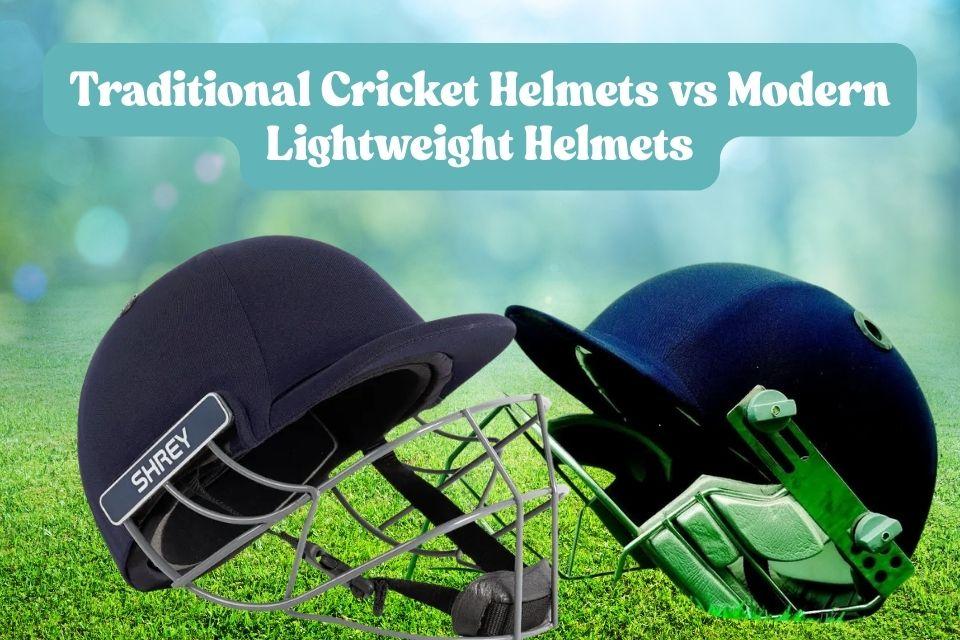


A cricket helmet is one of the most important pieces of protective gear for any batter or close-in fielder. But with so many options available today, you might be wondering—should you stick to the tried-and-tested traditional cricket helmets or go for the modern lightweight designs?
Let’s break down the differences, pros and cons, and help you choose the cricket helmet that best suits your game.
Overview
Traditional helmets have been around for decades and are built with a heavier, solid shell—usually made from high-grade fiberglass or metal composite. They’re known for maximum protection, especially against high-speed deliveries.
Advantages
Maximum Impact Protection: Thick shell and padding absorb even the hardest blows.
Durability: Designed to last for years if maintained properly.
Stable Fit: The weight and structure keep the helmet firmly in place during play.
Proven Safety: Used for decades at all levels, including international cricket.
Drawbacks
Heavier Weight: Can feel bulky during long innings, especially for younger players.
Less Ventilation: Older designs may cause discomfort in hot, humid conditions.
Limited Adjustability: Often have fixed padding, which might not fit all head shapes perfectly.
Overview
Modern helmets are made from advanced materials like high-impact polycarbonate, titanium grills, and reinforced carbon fiber. They focus on reducing weight without compromising safety.
Advantages
Lightweight Comfort: Easier on the neck and shoulders during long stays at the crease.
Improved Ventilation: Multiple air vents keep players cool.
Adjustable Fit: Advanced padding systems and adjustable straps for a more customized fit.
Stylish Designs: Sleek, aerodynamic looks that appeal to younger players.
Drawbacks
Slightly Higher Cost: Premium materials and design features can make them more expensive.
Durability Variance: Some lightweight models may need more careful handling to maintain integrity.
Side-by-Side Comparison
Feature | Traditional Helmet | Modern Lightweight Helmet |
Material | Fiberglass / metal composite | Polycarbonate, carbon fiber, titanium |
Weight | Heavy (~900g–1.2kg) | Light (~750g–900g) |
Protection Level | Excellent | Excellent (with advanced materials) |
Comfort | Good, but can feel hot | Very good, better ventilation |
Adjustability | Limited | High (adjustable padding & straps) |
Style | Classic | Sleek and modern |
Price Range | Generally lower | Slightly higher |
Choose a Traditional Helmet if:
You prioritize proven, heavy-duty protection.
You’re comfortable with a slightly heavier feel.
You play in conditions where ventilation isn’t a major issue.
Choose a Modern Lightweight Helmet if:
You value comfort and mobility for long innings.
You play in hot, humid conditions where ventilation is important.
You prefer adjustable features and a modern look.
Check Safety Standards: Look for certifications like BSI or ICC-approved safety compliance.
Fit is Key: The helmet should fit snugly without being too tight.
Test the Grill Gap: Ensure the gap between the peak and grill is small enough to prevent the ball from passing through.
Consider Your Role: Wicketkeepers standing up to the stumps may prefer slightly lighter, open-faced designs.
Buy From Trusted Brands: Shrey, SG, SS, Masuri, and Kookaburra are top choices.
Both traditional and modern helmets offer excellent protection—it ultimately comes down to your comfort preference, playing conditions, and budget. Traditional helmets give you a classic, battle-tested build, while modern lightweight helmets bring advanced comfort and breathability to the table.
If you’re ready to upgrade, check out SportsGear24x7 for authentic cricket helmets from the world’s best brands, with expert guidance to help you choose the perfect fit.
Q1. Are modern lightweight helmets as safe as traditional ones?
Yes—if they meet official safety standards, modern helmets can match or even exceed traditional models in protection.
Q2. Which is better for junior players?
Modern lightweight helmets are often preferred by juniors for comfort and reduced strain on the neck.
Q3. Can I use a helmet for both batting and wicketkeeping?
Some helmets are multi-purpose, but dedicated wicketkeeping helmets may offer better visibility and lighter weight.
Q4. How long should a cricket helmet last?
With proper care, 3–5 years, but replace immediately if damaged.
Q5. Should I replace the grill separately?
Yes, if the grill is bent or damaged, replace it to maintain full protection.